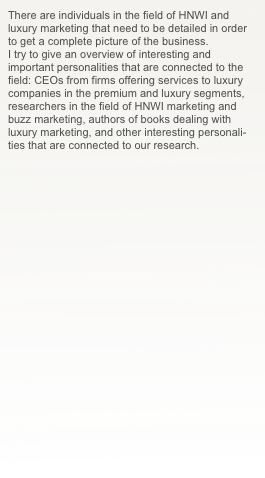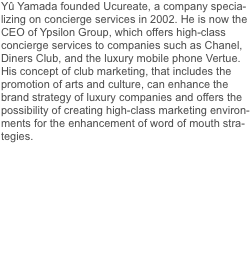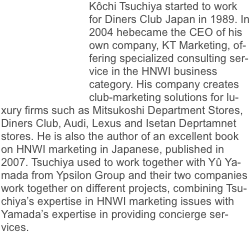






 |
 |
 |
Chadha is one of the two authors of “The Cult of the Luxury Brand” (2006), dealing with the “luxeplosion” that happened in Asia, explaining the effects the democratization of luxury has
on the brands, companies and the industry as a whole in different Asian
countries. The book draws on over 150 interviews with industry experts and
market studies in 10 countries, includingJapan.
 |
Husband co-authored “The Cult of the Luxury Brand” (2006) together with Radha Chadha.
 |
 |
 |
Chevalier is the author of the books, “Pro Logo” and “Luxury Brand Management”, with Gérald Mazzalovo.
 |
1986 persuaded Christian Lacroix to leave Patou and open the house Christian
Lacroix. 1987 purchases majority share in Céline, his first luxury goods company. 1988 negotiations with Alain Chevalier
(former chairman LVMH) to allow him to acquire a majo stake in LVMH. After
Chevalier stepped down, Henry Racamier and Arnault fought for 15 months for
control of the group (LVMH affair). The French daily Libération called Arnault “the Machiavelli of finance”. April 1990 Racamier resigned from Vuitton and LVMH. The Vuittons left the
avenue Montaigne headquarters, business passes out of the family’s hands (so much for preserving heritage of a brand).
Focus on start brands (timelss, modern, fast-growing, highly profitable). Older
brands that were acquired were renovated. New luxury model of Arnault: enhance
timelessness, jazz up the design, advertise.
1990 hires Yves Carcelle as head of strategy and development, after few months
promoted to CEO and chairman of LV. To refurbish the company’s heritage, Vuitton ad campaigns that romanticized luxury travel were launched,
sponsoring of antique car rallies, invited journalists to tour and write about
the Asnières workshop. Reintroduction of the Damier checkerboard canvas, launch of retro
handbag design. 1996 hired seven cutting-edge designers to reinterpret the
canvas and ran the creations as an ad campaign. Arnault wanted the attention of
the women’s ready-to-wear shows in New York, Paris, Milan. Arnault hires Marc Jacobs (just
fired from Ellis, bohemian, New York inspired, designing expensive clothes for
his freinds Sophia Coppola and the guitarist and singer from Sonic Youth). His
clothes immediately became critically acclaimed, sold at steep rpices, limited
to LV stores. The main function of the ready-to-wear line was to garner
headlines and to dress up ads to sell leather goods. Great attention, only 5%
of all sales of Vuitton.
Simultaneously, strengthening business side. Carcelle pulled production (70%
outsourced under Racamier’s reign) back in-house and increased number of factories from 5 to 14 in 10
years. Control of distribution: control of image. Control of factories: control
of quality (Arnault). By 2004, Vuitton earned gross margins of 80 percent.
Dior: Marc Bohan replaced in 1989 after 29 years by Italian Designer Ginafranco
Ferré. Givenchy: Arnault hires John Galliano. In 1996 Arnault moved Galliano from
Givenchy to Dior (not renewing Ferré’s contract). Alexander McQueen takes over the Givenchy job “Audry Hepburn is dead”. The press dubbes Arnault “Terminator”. “For an European, I have a U.S. approach [...] I face reality as it is and not as
I owuld like it to be. I build for the long term.” Many longtime old couture clients fled to more traditional houses such as Yevs
Saint Laurent and Chanel. Arnault didn’t care, Couture lost money. A new generation of Dior customers flooded the LVMH
brand stores to buy the new hip style. Perfume and handbag sales tripled, and
there it is where the big money was.
1999 after spending quietly $1.4 billion to 34,4% of Gucci stock, Arnault
launched a takeover bid. The white knight came in the form of Francois Pinault
(PPR). He bought 40% of Gucci, for $2.9 billion ($75 a share, 10% less than
Arnault). LVMH had a new competitor with the Gucci Group.
 |
1988, partly in response to trade sanctions against South Africa’s apartheid rule, Rupert seperated the luxury brands from the family’s tobacco and mining assets and moved them to Luxembourg and Switzerland, and
became CEO of the new group.
“In order to judge the ,ood and judge the future, you’ve got to go to the East. You’ve got to go to South America. You’ve got to walk the streets of New York.
Most of Richemont’s sales are in jewelry and watches. “We concentrate on style rather than fashion.”
1999 buys 60% of Prais jeweler Van Cleef & Arpels, 2002 purchase three luxury watch brands, Jaeger-LeCoultre,
International Watch Co., and A. Lange & Söhne, all form Vodaphone. He turned down offers by Tag Heuer, Ebel, Chaumet, and
Zenith. “It is also a question of whether you can support the brands you have when times
are bad ... In my view, you ultimately create shareholder value better by
building goodwill, rather than buying goodwill.”
Rupert keeps his companies independent of one another. “Product integrity has to be more importnat than synergies.”David Ogilvy [the advertising executive] used to say, ‘The consumer is not a bloody fool; she’s your wife.’ The consumer wants to know that Piaget watches are made in the Piaget factory.
[That’s] what makes it special. Otherwise it’s just another brand.”



















